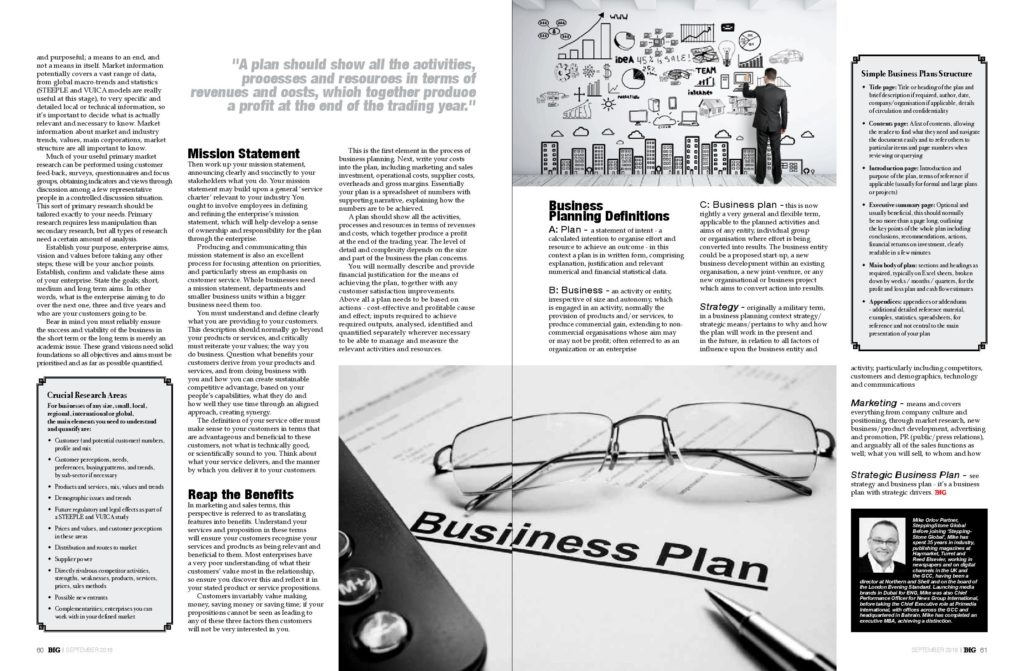
Over recent months we have been asked by many organizations for help with their business planning. This article is a simplified summary of basic pointers, which ought to give you a good start in getting your business plans down on paper and ensuring these plans are connected to action – making the plans happen.
Techniques of how to write strategic business plans are straight-forward. Business planning is mostly common-sense and logic, based on cause and effect. This guide explains how to define your enterprise’s purpose, put together a strategy and then craft a basic business plan and a customer-focused marketing and sales plan.
People use various terms referring to the business planning process – business plans, business strategy, marketing strategy, strategic business planning, marketing and sales planning – they all cover the same basic principles. When faced with business planning or a strategy development task it is important to clarify exactly what is required. Terms can be confused and can mean different things to different people so it is vital to clarify what needs to be done and agree these needs with others involved, rather than assume any meanings.
When writing a business plan, remember the most important driver for most business plans is return on investment, based on revenue from customers who recognize your value, and then buy-in on your purpose. The essential planning elements are identifying causes and effects, according to your relevant business drivers. In many enterprises a substantial business planning responsibility extends to front line customer-facing employees, and this trend is increasing. In this context, your business plan needs to incorporate a marketing and sales plan.
Define what you are going to sell to whom, when and how you are going to sell it, how much contribution (gross profit) these sales will produce, what the marketing and/or selling cost will be, and what will be the return on investment. The essentials of business planning, strategic business plans, sales plans and marketing planning are then quite straight-forward; inputs of resources then bundling these with planned processes and activities leading to defining your capabilities and thus producing outcomes and outputs.
The same principles and methods actually apply to very large complex global and multinational organisations – the only differences are scale and headquarters’ costs – typically fixed overheads – more spreadsheets, more lines and columns on each, more people crunching the numbers, and a couple of extra angles for the accountants, to tell them what they need to know about the profit and loss plan, cash flow estimates and the impact on the balance sheet.
It is vital you conduct and carry-out market research, including understanding your customers, focusing on your directly rivalrous competitors, understand possible substitutes, forecast new entrants into your market, and supplier-power.
Your market research should help you formulate business decisions. Market research should be pragmatic and purposeful; a means to an end, and not a means in itself. Market information potentially covers a vast range of data, from global macro-trends and statistics (STEEPLE and VUICA models are really useful at this stage), to very specific and detailed local or technical information, so it’s important to decide what is actually relevant and necessary to know. Market information about market and industry trends, values, main corporations, market structure are all important to know.

Much of your useful primary market research can be performed using customer feed-back, surveys, questionnaires and focus groups, obtaining indicators and views through discussion among a few representative people in a controlled discussion situation. This sort of primary research should be tailored exactly to your needs. Primary research requires less manipulation than secondary research, but all types of research need a certain amount of analysis.
Establish your purpose, enterprise aims, vision and values before taking any other steps; these will be your anchor points. Establish, confirm and validate these aims of your enterprise. State the goals; short, medium and long term aims. In other words, what is the enterprise aiming to do over the next one, three and five years and who are your customers going to be.
Bear in mind you must reliably ensure the success and viability of the business in the short term or the long term is merely an academic issue. These grand visions need solid foundations so all objectives and aims must be prioritised and as far as possible quantified.
Then work up your mission statement, announcing clearly and succinctly to your stakeholders what you do. Your mission statement may build upon a general ‘service charter’ relevant to your industry. You ought to involve employees in defining and refining the enterprise’s mission statement, which will help develop a sense of ownership and responsibility for the plan through the enterprise.
Producing and communicating this mission statement is also an excellent process for focusing attention on priorities, and particularly stress an emphasis on customer service. Whole businesses need a mission statement, departments and smaller business units within a bigger business need them too.
You must understand and define clearly what you are providing to your customers. This description should normally go beyond your products or services, and critically must reiterate your values; the way you do business. Question what benefits your customers derive from your products and services, and from doing business with you and how you can create sustainable competitive advantage, based on your people’s capabilities, what they do and how well they use time through an aligned approach, creating synergy.
The definition of your service offer must make sense to your customers in terms that are advantageous and beneficial to these customers, not what is technically good, or scientifically sound to you. Think about what your service delivers, and the manner by which you deliver it to your customers.
In marketing and sales terms, this perspective is referred to as translating features into benefits. Understand your services and proposition in these terms will ensure your customers recognize your services and products as being relevant and beneficial to them. Most enterprises have a very poor understanding of what their customers’ value most in the relationship, so ensure you discover this and reflect it in your stated product or service propositions.
Customers invariably value making money, saving money or saving time; if your propositions cannot be seen as leading to any of these three factors then customers will not be very interested in you.
This is the first element in the process of business planning. Next, write your costs into the plan, including marketing and sales investment, operational costs, supplier costs, overheads and gross margins. Essentially your plan is a spreadsheet of numbers with supporting narrative, explaining how the numbers are to be achieved.
A plan should show all the activities, processes and resources in terms of revenues and costs, which together produce a profit at the end of the trading year. The level of detail and complexity depends on the size and part of the business the plan concerns.
You will normally describe and provide financial justification for the means of achieving the plan, together with any customer satisfaction improvements. Above all a plan needs to be based on actions – cost-effective and profitable cause and effect; inputs required to achieve required outputs, analysed, identified and quantified separately wherever necessary to be able to manage and measure the relevant activities and resources.
Simple Business Plans Structure
- Title page: Title or heading of the plan and brief description if required, author, date, company/organisation if applicable, details of circulation and confidentiality
- Contents page: A list of contents, allowing the reader to find what they need and navigate the document easily and to refer others to particular items and page numbers when reviewing or querying
- Introduction page: Introduction and purpose of the plan, terms of reference if applicable (usually for formal and large plans or projects)
- Executive summary page: Optional and usually beneficial, this should normally be no more than a page long, outlining the key points of the whole plan including conclusions, recommendations, actions, financial returns on investment, clearly readable in a few minutes
- Main body of plan: sections and headings as required, typically on Excel sheets, broken down by weeks / months / quarters, for the profit and loss plan and cash flow estimates
- Appendices: appendices or addendums – additional detailed reference material, examples, statistics, spreadsheets, for reference and not central to the main presentation of your plan
Business Planning Definitions
A: Plan – a statement of intent – a calculated intention to organise effort and resource to achieve an outcome – in this context a plan is in written form, comprising explanation, justification and relevant numerical and financial statistical data. In a business context a plan’s numerical data – costs and revenues – are normally scheduled over at least one trading year, broken down weekly, monthly quarterly and cumulatively.
B: Business – an activity or entity, irrespective of size and autonomy, which is engaged in an activity, normally the provision of products and/or services, to produce commercial gain, extending to non-commercial organisations whose aim may or may not be profit; often referred to as an organization or an enterprise
C: Business plan – this is now rightly a very general and flexible term, applicable to the planned activities and aims of any entity, individual group or organisation where effort is being converted into results
The business entity could be a proposed start-up, a new business development within an existing organisation, a new joint-venture, or any new organisational or business project which aims to convert action into results. The extent to which a business plan includes costs and overheads activities and resources (production, research and development, warehouse, storage, transport, distribution, wastage, shrinkage, head office, training, bad debts) depends on the needs of the business and the purpose of the plan. Large ‘executive-level’ business plans therefore look rather like a ‘predictive profit and loss account’, fully itemised down to the ‘bottom line’
Strategy – originally a military term, in a business planning context strategy/strategic means/pertains to why and how the plan will work in the present and in the future, in relation to all factors of influence upon the business entity and activity, particularly including competitors, customers and demographics, technology and communications
Marketing – means and covers everything from company culture and positioning, through market research, new business/product development, advertising and promotion, PR (public/press relations), and arguably all of the sales functions as well; what you will sell, to whom and how
Strategic BusinessPplan – see strategy and business plan – it’s a business plan with strategic drivers
Research
For businesses of any size, small, local, regional, international or global, the main elements you need to understand and quantify are:
- Customer (and potential customer) numbers, profile and mix
- Customer perceptions, needs, preferences, buying patterns, and trends, by sub-sector if necessary
- Products and services, mix, values and trends
- Demographic issues and trends
- Future regulatory and legal effects as part of a STEEPLE and VUICA study
- Prices and values, and customer perceptions in these areas
- Distribution and routes to market
- Supplier power
- Directly rivalrous competitor activities, strengths, weaknesses, products, services, prices, sales methods
- Possible new entrants
- Complementarities; enterprises you can work with in your defined market
